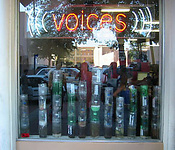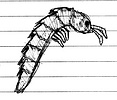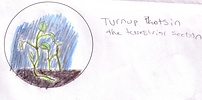Introduction


Ecobottles the City High Division 1 Students (Freshmen) made just after they were sealed and placed in the school's front window to get sunlight © 2005
City High School 9th graders in Tucson, Arizona built ecobottles to explore ecosystems on a small scale. Each ecobottle contained three sections: a terrestrial section, an aquatic section and a decomposition section. Students devised plans for each section and researched the type of organisms they could add to each zone; then they collected all of the materials themselves.
As part of the project, students visited Tucson's Biosphere2, the world's largest "ecobottle" with its artificial rain forest, deserts, savannahs, farms and miniature ocean. Overall, the class agreed that they learned a lot in the process of creating "mini-worlds" and observing their development over the course of two months. The students' documentation of their work was an important part of the project, and provided the basis for the treehouse investigations that are part of this portfolio.
Portfolio Pages
- Seal Group Ecobottle Study
-
 © 2005 Seal1
© 2005 Seal1
- Hey Hey Hey! This is the Ecobottle page of The Seals. We are a group of freshman students who are currently attending City High School. We're studying Ecobottles (which are basically mini recreations of ecosystems) and how they change and develop over a period of time. This treehouse documents our groups' observations and the data we collected throughout our project. This is a collection of the information we learned over the time we observed our ecobottle, and in a way it's a guide for other people trying to learn how to make a successful ecobottle. Making an ecosystem is harder that it seems, so hopefully you can learn from our mistakes.
- Ninja Group Ecobottle Study
-
 © 2005 Ninja4
© 2005 Ninja4
- We learned a lot from this project. We learned that not only do you have to know how to do this, you have to want to do this. If we were to do this project again, there are definitely some things we would change. First, we would put rocks in the aquatic, not sand. Secondly, we wouldn't put stuff that can mold in the decomposition. That was a bad idea because the mold transferred to the water and killed the plant that the fish ate, therefore killing the fish. It also got onto the once-thriving bean plant, making it shrivel up. We think the mold got onto the straw that had access to all the chambers. Some questions we have are: 1) How did the larvae and water fleas get inside a closed environment? 2) What kind of mold was it that killed everything? I, Cassinova, learned a lot from this project. First, I learned the obvious: how to build and maintain a closed environment. Secondly, I learned how much work and effort this took. You have to have a passion for this kind of work to really get what you're doing and want to do this. I also learned a lot about habitats and the different kinds of environments they help create. This project was a great learning experience that required a lot of work, but it was worth it. This is Kingsley, Cassinova, and Zulu saying adios.</p>
- Cockroach Group Ecobottle Study
-
 © 2005
© 2005
- We are the cockroach group, and project that we are presenting here is called an ecobottle investigation. In our class we are doing ecobottles to learn more about what scientists have to do in their everyday life. Also it makes us better observers and more prepared in daily life when we get older if we become scientists. What we learned from this is what I just explained. But there are more things we learned from this project, like how the terrestrial, decomposition and aquatic sections work as their own environments and how they interact together.
- Generic's Groups Ecobottle Study
-
 © 2005
© 2005
- We made our ecobottle to see if we could create an ecosystem that works. In our case, it didn't quite work, but we did learn a few things about ecosystems and the world in general. It was fun, if a little disappointing that our ecobottle didn't come out well. You can see on our treehouse what our bottle looked like, as well as see things we did such as observations and our Timeline of Deaths which displays the dates that organisms in our ecobottle died. There are also some other pictures showing various diagrams and parts of our ecobottle.
- Cactus Group Ecobottle Study
-
 © 2005
© 2005
- Even though we didn't put a lot of organisms in our ecobottle, we still had a chance to observe what happened over the course of almost 2 months. In the aquatic section, our water grew darker and darker, and began leaking out. In our terrestrial section our snails died but the radish plant survived for the whole time. If we were going to make another ecobottle, we would put more organisms in it, and plan more to make sure that all the plants and animals had the right conditions for survival.
- Scienceperson Group Ecobottle Study
-
 © 2005 scienceperson6
© 2005 scienceperson6
- We created the ecobottles to build a little ecosystem, and we watched how everything is like a chain. If something happens to the first level something else will happen to all the other levels; when something happens to one thing there is also an effect on everything else. I think it is very interesting to watch things die off and some other things to come to life. The things that came to life were a bunch of little worms, some mold, and a few fruit flies. The things that died were a grasshopper, a fish, and a bunch of worms. It was really cool to watch because sometimes we had no idea how those things came to life. I think that we all had a lot of fun working together on this project and we learned a lot from all this. It felt like we made our own little world.
- Guppy Group Ecobottle Study
-
 © 2005
© 2005
- The "Guppy" Ecobottle clearly stands out from the rest. With two guppies, a variety of bugs, crickets and a praying mantis, our ecobottle proves to be the best. Lots of planning occurred before the ecobottle was built. For example, our first plan was to put frogs in the terrestrial area but several conflicts rose up within the group around doing so, and our group decided not to. After planning, our group proceeded to build the actual project. Once the building was done, the group had no concept of what would occur in the coming weeks with the miniature ecosystem. The feeling of not knowing what would happen next, was an exciting motivation for our group. In the terrestrial area was a praying mantis. Our mantis lived for quite a while, surviving on both grass and crickets. In our decomposition area, we had a variety of bugs, mainly aphids. This area consisted of soil compost and leaves from trees throughout Tucson. In our aquatic area were two proud male guppies that we jokingly named 'Seigfried and Roy,' comparing them to the famous magicians. On a daily basis, observation of the project took place. The observations were recorded in each of our group members' individual fieldbooks. We tested the pH level of the water frequently, and checked the water temperature daily. That temperature averaged around 77 degrees Fahrenheit. In conclusion, the 'breaking apart' of our ecobottle was successful. The crickets and bugs were released to live freely into the world, and Seigfreid and Roy happily went home with one of our group members. Our ecobottle was among one of the few that thrived, and in our minds, it was the best of the ecobottles in this time-consuming yet fun project!
- Mantis Group Ecobottle Study
-
 © 2005
© 2005
- We learned about the praying mantis and how it lives. And we learned that you can make a whole ecosystem out of soda bottles. By observing the ecobottle, we learned how the whole ecosystem works, and how one thing can affect everything in the ecosystem. One thing that surprised us is how long the praying mantis lived because it had no food. We thought it would die sooner, but it lived two times longer than we predicted.
- Sloth Group Ecobottle Study
-
 © 2005
© 2005
- We made this ecobottle to see what would happen if we made an environment that would survive on its own. There are three different environments in the bottle. There is an aquatic environment, a decomposition environment, and a terrestrial environment.
- Mutant Group Ecobottle Study
-
 © 2005 Mutant2
© 2005 Mutant2
- The first week was quite a surprise for our group. Originally we had these organisms living in our ecobottle (they were separated by the level they inhabited). Terrestrial: One scorpion, eight crickets, and one lima bean plant. Aquatic: Two snails, and one water plant. Decomposition: Dirt, apples, water, and some kind of vegetable I can't remember at the moment. From the very first week we all assumed that each of the organisms would kick the bucket before the end of three short weeks, so we waited and watched. We observed the activities and habits of the ecobottle-organisms, and shockingly enough, nothing had yet died. The scorpion (Melvin) stayed below ground most of the time, buried deep inside the soil. Although he did kill a cricket in the first week, we unfortunately did not get an opportunity to witness any brutal killings. The crickets scurried around, eating the apples we had provided for them. Our plants were growing nicely, our snails were alive and well, our water was clear, and the produce was decomposing slowly. So over all, the first week was a successful venture.
- Rollingthunder Group Ecobottle Study
-
 © 2005 Rollingthunder3
© 2005 Rollingthunder3
- We completed our ecobottles so we could find out what the keys to an ecosystem chain are, and so that we could see what things are needed in this chain. For instance, in order to keep clean water, we had to put in a coffee filter with sand to filter it. In the terrestrial chamber, we had to put dirt and sand for the worms and crickets. From this ecobottle we learned in what order certain objects should be put into the bottle. We also learned how much time everything takes to grow. Before you start your ecobottle, you have to know about the tree of life and what everything needs to survive, and include that "everything" in your ecobottle. Many things will die, but that's how it works. Do research on what plants to get and make a full habitat for that organism. For our next project we will make sure the water is cleaner so we can study fish and other aquatic creatures. We need to know how many layers of filter paper we need to put in to make sure to water is clear. Next time we do this project, we will research what types of worms work best in the soil, and make sure everything connects.
- Snail Group Ecobottle Study
-
 © 2005 Snail1
© 2005 Snail1
- Have you ever wondered what its like to build a miniature planet Earth in your science classroom? Well, myself and two other classmates have done that very thing. We call them, Ecobottles. Ecobottles have three main chambers, each acting as different parts of the Earth. The terrestrial chamber, which is where things like plants and small creatures would live, the decomposition chamber, which is the same as under the surface of the Earth, and the aquatic chamber, which is the same as the oceans and lakes on the Earth. Through this process of creating a miniature Earth, we have we have been able to carefully watch the Ecobottle and see exactly how and why it's changing. And in a sense, its almost like how our planet changes and reacts to certain situations that it is put into.
Information on the Internet
- Annenberg Media: Bottle Biology The Bottle Biology site is a great place to learn about how to make ecocolumns.
- Wisconsin Fast Plants The Fast Plants site provides a wealth of information on how to use special types of plants for ecobottle investigations.


 Go to quick links
Go to quick search
Go to navigation for this section of the ToL site
Go to detailed links for the ToL site
Go to quick links
Go to quick search
Go to navigation for this section of the ToL site
Go to detailed links for the ToL site